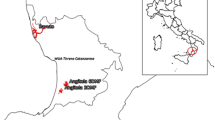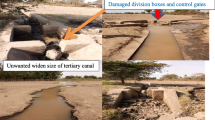Abstract
The endeavor of controlling the use of irrigation water is important for improving water quantities’ sustainability in water-poor regions. Efficient on-field usage of water needs an adaptable water source in amount and interval which is beneath the farmer control at the location of use. For the traditional irrigation, the usage of great amount of water for irrigation is fundamental and reasonable, particularly when reflecting the improved irrigation effectiveness and decreased labor wants. Mechanization and constancy of water flow at the field are usually achieved by use of flexible on-field Irrigation techniques. The main objective of this research paper is to compare between the cost of the flexible on-field irrigation and the traditional—drip and sprinkler—systems and demonstrate the best system for two study cases, one of which is irrigated with a drip system on bahr Yousef canal in the city of Somosta, Benisuef Governorate, and another is irrigated with sprinkler system on Abu Eldahab canal in the city of the east of Alqantra, Ismailia Governorate, Egypt. In this paper, the method of calculating irrigation costs relies on the expense of the costs resulting from the cost of labors, the cost of fuel and the cost of pumps that raise and deliver water to farms. The study showed that 9% and 27% of the total cost is reduced and 14% and 56% of the consumed water is saved when the flexible irrigation system is used instead of the drip and sprinkler systems, respectively.



Similar content being viewed by others
References
Akbar M., Seyed J., Nasser S., Mohammadreza N. (2020) “Pistachio (Pistachia vera L.) seedling growth response to irrigation method and volume in Iran”, Agricultural Water Management. https://doi.org/10.1016/j.agwat.2020.106287
Braz-Tangerino F et al (2014) Visi´on del regadío. Ingeniería del Agua 18(1):39–53 (in Spanish)
Darell Zimbelman, D.WRE (2014) Canal automation for irrigation systems.TC753.C36, ISBN 978–0–7844–1368–5.
Dong W, Huihui Z, Jim G (2019) Long-term productivity of early season peach trees under different irrigation methods and postharvest deficit irrigation. Agric Water Manag. https://doi.org/10.1016/j.agwat.2019.105940
Falkenmark M, Rockström J (2010) Building water resilience in the face of global change: From a blue-only to a green-blue water approach to land-water management. J Water Resour Plann Manage. https://doi.org/10.1061/(ASCE)WR.1943-5452.0000118, 606–610.
Guohua Zhang, Chongbao Xie, Haojie Lai, Xinhu Li (2017), "Buried Lifting Sprinkling Irrigation Device" 10.1061/ (ASCE) IR.1943–4774.0001264.
H. A. Mansour, M. Abd el-hady, V. F. Bralts, B. A. Engel (2016) Performance Automation Controller of Drip Irrigation Systems Using Saline Water for Wheat Yield and Water Productivity in Egypt. 10.1061/ (ASCE) IR 1943–4774.0001042.
Merriam JL, Freeman BJ (2007). Operational cost benefits study of flexible on-farm irrigation supply systems. https://doi.org/10.1061/(ASCE)07339437(2007)133:1(12)
Khan S, Hanjra MA (2009) Footprints of water and energy inputs in food production—Global perspectives. Food Policy 34(2):130–140
Delavar M, Moghadasi M, Morid S (2012). Real-time model for optimal water allocation in irrigation systems during droughts. https://doi.org/10.1061/(ASCE)IR.1943-4774.0000440
Mohamed Abdel Atty (2014) Egypt's Strategy for Managing Water Resources. Ministry of Water Resources and Irrigation, Egypt February 2014
Albaji M, Boroomand-Nasab S, Naseri AbdAli, Jafari S (2010). Comparison of different irrigation methods based on the parametric evaluation approach in Abbas Plain. https://doi.org/10.1061/_ASCE_IR.1943-4774.0000142
Nadia El-Hage (2014) Climate, energy and tenure division. The Food Wastage Footprint (FWF) Report.
Rohan S., Sagar K., Adesh G., Sagar T. and Adesh P. (2019) A review on different irrigation methods. International Journal of Applied Agricultural Research.
Taylor, K. A., Shamshery, P., Wang, R. Q., winter, A. G. (2015) A mathematical model for pressure compensating emitters. International Design Engineering, Technical Conferences and Computers and Information in Engineering Conference. ASME, Boston, MA.
Valipour M (2016) (2016) How do different factors impact agricultural water management? Open Agriculture 1:89–111. https://doi.org/10.1515/opag-2016-0014
Valipour M (2017) Global experience on irrigation management under different scenarios. J Water Land Development 32:95–102. https://doi.org/10.1515/jwld-2017-0011
Panagopoulos Y, Makropoulos C, Kossida M, Mimikou M (2013). Optimal implementation of irrigation practices: cost-effective desertification action plan for the Pinios Basin. https://doi.org/10.1061/(ASCE)WR.1943-5452.0000428
Author information
Authors and Affiliations
Corresponding author
Ethics declarations
Conflict of interest
The authors have no conflicts of interest to declare. All co-authors have seen and agree with the contents of the manuscript and there is no financial interest to report. We certify that the submission is original work and is not under review at any other publication.
Rights and permissions
About this article
Cite this article
Abdel-Hamid , M., Abdelhaleem, H.M. Cost benefits analysis of flexible on-field irrigation systems: a case study. Innov. Infrastruct. Solut. 7, 7 (2022). https://doi.org/10.1007/s41062-021-00594-x
Received:
Accepted:
Published:
DOI: https://doi.org/10.1007/s41062-021-00594-x




